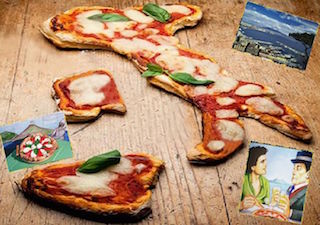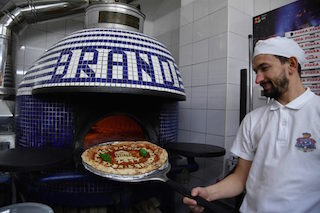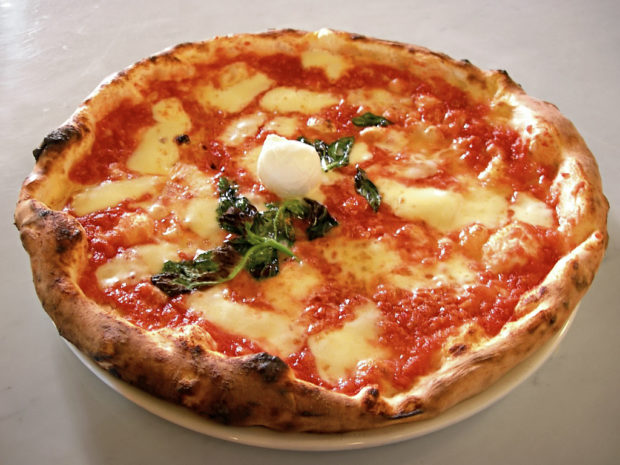Perhaps thanks to the over 2 million people who’d signed a petition supporting Naples’ candidacy, on December 6th UNESCO’s World Heritage Committee, founded in 2003, added the art of “pizzaiuolo” or “of Neapolitan pizza twirling” to its list of more than 350 traditions, art forms, and practices recognized as “world intangible heritage”. Ten other recognitions have been awarded to Italy; in 2008: Sicilian puppetry and Sardinian pastoral songs; in 2012 traditional violin craftmanship in Cremona; in 2013 shoulder-borne structures for religious processions in Nola, Palmi, Sassari, and Viterbo as well as the Mediterranean Diet; in 2014 the traditional agricultural practice of cultivating the vite ad alberello” (head-trained vines) on the island of Pantelleria and the “Vineyard landscapes of the Langhe, Roero,and Monferrato”; in 2015 “Parma: A UNESCO city of Creative Gastronomy”; in 2016 along with numerous other nations falconry; and this year “Alba: A UNESCO City of Creative Gastronomy”.

The art of “pizzaiuolo” has been handed down for generations in Naples. The custom goes far beyond the pizzaiuolo’s spectacular handing of the dough–hurling into the air in order to “oxygenate” it—to include songs, stories and gestures that have turned pizza-making in Naples into a time-honored social ritual with several stages. The committee’s motivation was that “pizza twirling is a rite in which the oven and the counter function as a stage” and that the twirlers are artists.
Indeed an Italian law has spelled out six regole d’arte or rules for the making of a “pizza DOC” or pizza napoletana verace, in other words, a genuine Neapolitan pizza: 1) the tomatoes must be San Marzano, 2) the mozzarella buffalo-milk, 3) the oil must be olive, 4) the salt natural not imitation, 5) the oven must be domed, made of bricks, and wood-buring at between 420-80 degrees, and 6)the dough must be kneaded by hand with no rolling pins or blenders allowed.
To make sure these standards are enforced in 1984 the Associazione Verace Pizza Napoletana, Via S. Maria la Nova 49, tel. +39-0814201205, was founded. Ironically would-be pizzaiuoli, if not part of a family dynasty, to learn the trade have to enroll in one of Italy’s two Accademie della pizza in Brescia or in Caorle, half-way between Venice and Trieste, not in Naples, believe-it-or-not!
Although UNESCO’s recognition is for the profession and not the product, Maurizio Martina, Italy’s Minister of Agriculture, Food, and Forestry, tweeted “Victory, another step towards the protection of Italy’s food and wine heritage”. The art of the Neapolitan pizza-maker contains Italian know-how…especially traditional knowledge that has been transmitted from generation to generation. This honor couldn’t have come at a more propitious time; 2018 is the Year of Italian Food.”
Indeed, although pizza, the same word in all languages, was almost certainly born more than 3,000 years ago in ancient Egypt, it’s the single food most firmly associated with Italy and particularly with Naples. The first documented pizzas were eaten in ancient Pompeii and Herculaneum, where archaeologists have uncovered brick pizzas ovens. But it was pizza without mozzarella and tomatoes.

When the Lombards invaded the boot and settled between Rome and Naples after the fall of the Roman Empire, they brought buffaloes with them and produced the first mozzarellas from buffalo milk. Another 1,000 years–in 1552 to be exact–had to elapse before the first tomato would be seen in Europe, when, according to local legend, Neapolitan sailors brought the first seeds back from Peru.
Although the tomato was held in low esteem-it was believed to be poisonous-by most Europeans, the poor people of Naples, subsisting quite literally on their daily bread, added this new ingredient to their yeast dough and created the first simple pizza which they purchased “oggi a otto”, meaning that they promised to pay for it “within eight days from today”, and ate it with their hands like street food. By the seventeen century it had achieved a notoreity among visitors who would go to poor neighborhoods, in particular the “Quartieri Spagnoli” or “Spanish Quarters” to taste the handmade peasant dish, but it still remained a local specialty sold from open-air stands and street vendors.
As for mozzarella, it was not until the nineteenth century-about 300 years after the tomato-that mozzarella (still made from buffalo, not cow’s, milk), became a standard pizza ingredient.

Legend has it that during a royal visit in the summer of 1889 the famous Neapolitan pizzaiuolo Raffaele Esposito of the “Pizzeria Brandi” prepared several calzoni and pizzas with different toppings for Queen Margherita. One was “Mastu Nicola” or white pizza with lard, basil, pecorino cheese and peper; another with tomato, anchovies, garlic, oregano, and olive oil. Then thinking that the commonly-used seasoning of bad-smelling garlic was unworthy of royalty, he replaced it with mozzarella. The Queen preferred Esposito’s topping with tomato, basil and mozzarella which from then on has been named for her: “pizza margherita” or “pizza tricolore” for the Italian flag. The very same oven that Esposito used for the queen, now in the Capodimonte Museum, was used to fire last week’s pizzas for the celebrating VIPS.

Nonetheless, in spite of the Queen’s enthusiams, pizza remained a local Neapolitan delicacy until the concept crossed the Atlantic at the turn of the last century in the memories of immigrants from Naples who settled in the cities along the eastern seaboard of the United States, especially New York.
The first licensed pizzeria in New York was opened by Gennaro Lombardi, a pizzaiuolo from Naples, in 1895 on Spring Street, but others quickly followed in the Italian communities around the city. Still, pizza and pizzerias, later called “pizza parlors” were little known outside the large cities of the East until after World War II, when returning American G.I.s brought back a taste for the pizzas they’d had in Naples during the Allies’ occupation along with the assumption that pizza, like spaghetti and meatballs, was a typical Italian dish, instead of a regional one.
In fact, until about twenty years ago it was next to impossible to find pizza on the menu north of Rome. Today, however, according to Burton Anderson, in his delightful Treasures of the Italian Table (William Morrow, 1994), Italians eat more than 2.5 billion pizzas a year, more than 45 per person, in over 38,000 pizzerie for a profit of over 6.3 billion dollars. Other statistics report that 82% of Italy’s population chose pizza as their favorite food; 61.8% go to a pizzeria every weekend; and 75% of these eat there, for the other 25% it’s take-home. For comparison the USA counts some 70,000 pizzerie and Americans eat 3 billion pizzas a year.
Instead, more up-to-date statistics reported in Rome’s newspaper Il Messaggero on December 8: In Italy every year 63,000 pizzerie bake 5,000,000 for a value of 10 billion euros with 100,000 pizzaiuoli working everyday and another 50,000 on weekends. Each Ameircan eats 13 chilos of pizza every year, the Italians 7,6, Spanish 4.3, the French and Germans 4.2, the Belgians 3.8, and the Portuguese 3,3.
 Although the American promotion of pizza has resulted in its becoming an international favorite, from Tuscaloosa to Tokyo, nonetheless, Naples remains “the place” for a pizza, even if Rome has become a serious rival. Some say it’s all in the water which explains why Neapolitan coffee is considered the nation’s best, but that’s another story. Naples’s best pizzerias, are 179-year-old Port’Alba; Pasquale Parziale’s O Caffone; Bellini, a favorite with students in spite of its surly waiters; family-run Da Michele, founded in 1870 by Michele Condurro and now run by his great-grandchildren, which serves only pizza margherita (mozzarella, tomato, and basil), Pavorotti’s favorite, and pizza marinara (tomato, garlic, and anchovies); Il Pizzaiolo del Presidente, where Clinton stopped for a snack of margherita piegata in quattro (“folded in four”), considered by the proprietor, Ernesto Cacialli, to be the only real pizza; and Trianon da Ciro, with marble-topped tables and delicious “pizza lasagna”. The owner of Brandi near the San Carlo Opera House, is a descendant of the margherita’s inventor’s wife; and Antonio Pace, the owner of Ciro a Santa Brigida claims one of his ancestors invented the “quattro stagioni” or “four seasons” with its four different toppings to please his family’s different palates. The onominous house specialty at 50 Kalò (fresh tomato, black olives, capers, mozzarella, and escarole), opened by 4th generation pizzaiuolo Ciro Salvo, is to die-for.
Although the American promotion of pizza has resulted in its becoming an international favorite, from Tuscaloosa to Tokyo, nonetheless, Naples remains “the place” for a pizza, even if Rome has become a serious rival. Some say it’s all in the water which explains why Neapolitan coffee is considered the nation’s best, but that’s another story. Naples’s best pizzerias, are 179-year-old Port’Alba; Pasquale Parziale’s O Caffone; Bellini, a favorite with students in spite of its surly waiters; family-run Da Michele, founded in 1870 by Michele Condurro and now run by his great-grandchildren, which serves only pizza margherita (mozzarella, tomato, and basil), Pavorotti’s favorite, and pizza marinara (tomato, garlic, and anchovies); Il Pizzaiolo del Presidente, where Clinton stopped for a snack of margherita piegata in quattro (“folded in four”), considered by the proprietor, Ernesto Cacialli, to be the only real pizza; and Trianon da Ciro, with marble-topped tables and delicious “pizza lasagna”. The owner of Brandi near the San Carlo Opera House, is a descendant of the margherita’s inventor’s wife; and Antonio Pace, the owner of Ciro a Santa Brigida claims one of his ancestors invented the “quattro stagioni” or “four seasons” with its four different toppings to please his family’s different palates. The onominous house specialty at 50 Kalò (fresh tomato, black olives, capers, mozzarella, and escarole), opened by 4th generation pizzaiuolo Ciro Salvo, is to die-for.
Nota bene: New York food critic Ed Levine, author of Pizza: A Slice of Heaven, says the best pizza in the USA isn’t baked in the Big Apple, but in Phoenix, Arizona, by Bronx-born Chris Bianco at his Pizzeria Bianco.
Pizza fans unite! February 9th is International Pizza Day.












